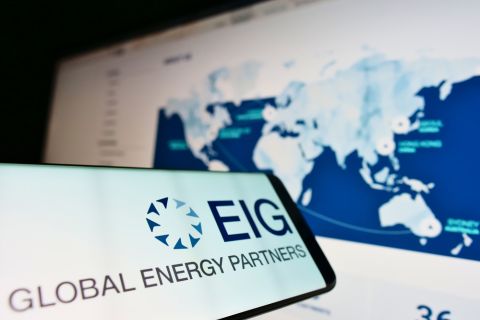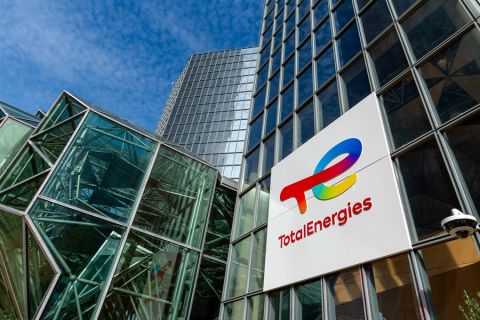When the FPSO serving the Etame Field in Gabon was about to go out of class, VAALCO Energy Inc.'s management had to make a critical decision to preserve its sole source of revenue.
The independent operator saw two main options: it could bring in another FPSO or move all the processing onto the platform and use an FSO instead.
Once the decision to switch to an FSO was made in April 2021, the company took action immediately. The complex project, carried out during the height of the COVID pandemic, required tight choreography of supply chain deliveries and well-planned engineering, construction and installation activities —alongside concurrent operations on the shallow water field.
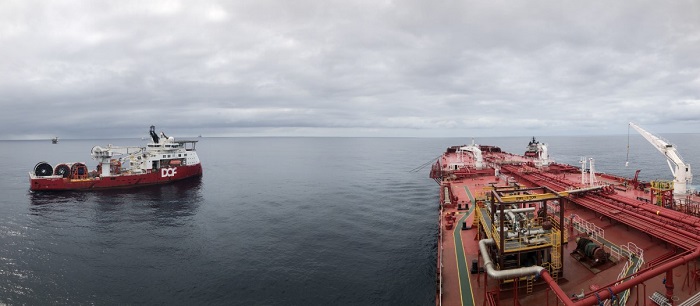
George Maxwell, who was appointed VAALCO CEO in April 2021, recalls spirited debates as the company worked out the best approach for how to continue producing the Etame Field in the Etame Marin Permit PSA offshore Gabon.
VAALCO’s hand was being forced. The vessel serving Etame, the Petroleo Nautipa FPSO, owned and operated by BW Offshore, was going out of class at the end of 2022. It would not be economic to upgrade it given the vessel’s age.
“It was a critical decision point. We had to move. If we didn’t move, we were going to run out of time,” Maxwell said.
One of the complicating factors that shaped VAALCO’s decision making, said CFO Ron Bain, was that Etame was the company’s meal ticket. If the field was shut in, so was cash flow.
“We’re not Exxon. We’re not Chevron. We haven’t got a massive balance sheet to allow us to throw all the money at it,” Bain said. “You need to think in a different way.”
FPSO or FSO?
The company was initially drawn to the obvious solution of bringing in another FPSO. But Maxwell said there were concerns around how quickly a new FPSO would be available and how much it would cost, among other factors.
“We discounted the cookie-cutter approach as expensive and not meeting economies of scale,” he said.
James Waithman, VAALCO’s director of engineering and technical services, said there was also reluctance to continue relying on an FPSO for other reasons.
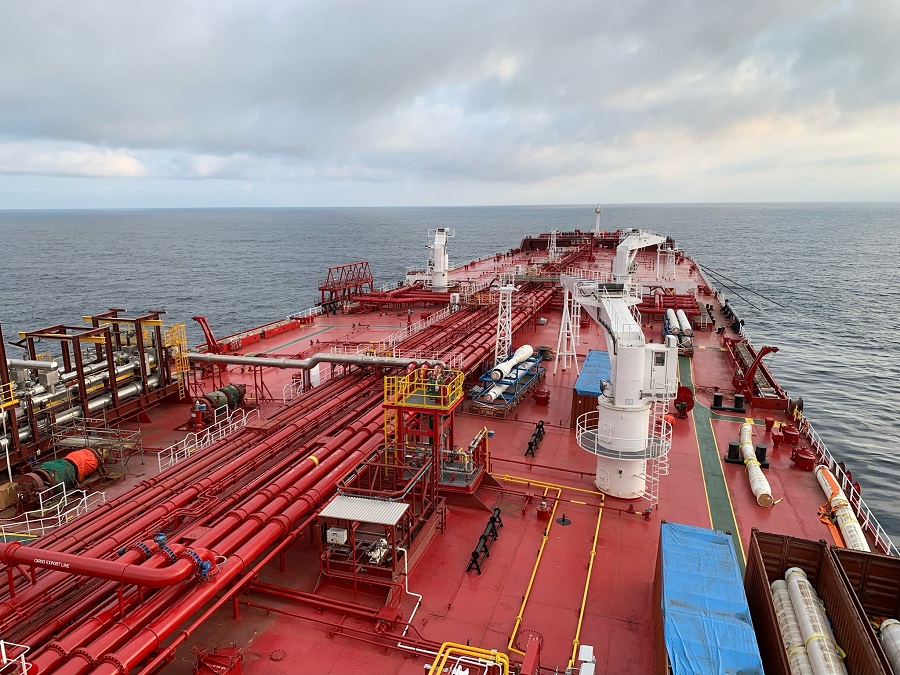
The cost to continue to use the FPSOs was only going to go up, he said. But there was a larger issue.
“When the cornerstone of your field is owned and operated by someone else, it puts you in a terrible position,” Waithman said, particularly when it’s time to renegotiate or renew a contract and “you can’t necessarily afford to bring in something new.”
Once VAALCO opted to reconfigure the platform to handle processing and bring in an FSO vessel, the management team didn’t second guess itself, Maxwell said. At the same time, it focused on controlling the two key factors it could: cost and production.
“Everything we tried to do, solve and engineer was around cost and production,” Maxwell said.
Of course, at the time VAALCO decided to move forward with the reconfiguration plan, the company didn’t anticipate the supply chain issues that would crop up or the complexity that would add to the project, Bain said.
“We still managed to do it on time and largely within budget,” Bain said.
On the other hand, Maxwell noted, because VAALCO made the decision to move ahead on the project in April 2021, the company was able to contract activity at relatively competitive prices. Had the company waited six months or eight months more to take action on the project, he said, the cost would have been quite high.
Early Etame evolution
The Etame field was first discovered in the Etame Marin Permit offshore Gabon in 1998.
“Nobody knew what to do about the discovery they’d found there,” Waithman said. “VAALCO decided to do something.”
That decision revolved around a lower-cost fit-for-purpose FPSO moored in 250 ft water depth. Etame Field reached first oil in 2002.
The Ebouri and Avouma discoveries followed in 2004. In 2007, the Avouma Field began producing to the Petroleo Nautipa FPSO via a subsea tieback, and in 2009, the Ebouri Field added its contribution to the Petroleo Nautipa FPSO. VAALCO reported the Southeast Etame discovery in 2011. In 2013 and 2014, VAALCO installed and brought online the Etame and Southeast Etame and North Tchibala platforms, which fed production to the Petroleo Nautipa FPSO.
Maxwell said that investment created processing redundancy that “allowed us to dumb down the facility.”
And nearly two decades after the field first began production, there were four platforms on the permit acreage, and the platform’s processing equipment was “sending a fairly refined product to the storage tanks on the FPSO,” Waithman said. “We didn’t need 90% of the processing equipment on the FPSO. We’d installed that on the field over the years.”
Those investments, he said, made it easier to decouple the field from the Petroleo Nautipa FPSO.
During 2021 and 2022, VAALCO replaced the Petroleo Nautipa FPSO with a converted FSO, reconfigured the Etame subsea infrastructure and upgraded the central processing facility, all while keeping the Etame Field online.
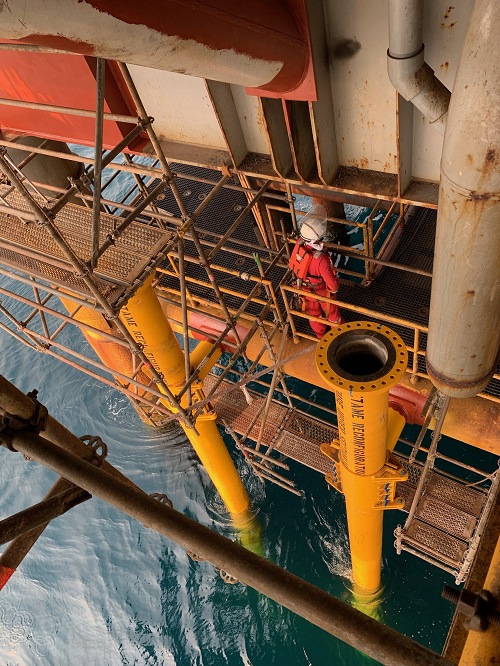
Etame expansion
One of the big jobs, Bain said, was extending the Etame platform deck.
“We were effectively putting on an additional part of the platform offshore, live on the project,” he said.
To do so, VAALCO started with a 3D scan of the existing facility to enable effective design of the extension.
“It came to fruition exactly as it was planned. That was absolutely huge,” Bain said. “I don’t think we could have done that 10 years ago” because the technology was not as advanced at the time.
The Etame platform deck needed to be extended to accommodate equipment packages that allow it to serve as the central processing hub for the Etame Field.
The previously installed platforms all had processing capacity, which made processing on a vessel unnecessary. Bringing in an FSO instead had the effect of nearly halving daily storage and offloading costs for Etame, Bain said.
The Cap Diamant, a double-hull crude tanker built in 2001, was converted at the Arab Shipbuilding and Repair Yard in Bahrain to serve the Etame Field as FSO. Named Teli FSO, it can store 1 MMbbl and provides 50% more storage than the Petroleo Nautipa FPSO. It is expected to help extend Etame’s economic field life through 2030 and beyond.
In addition to extending the Etame platform deck and securing an FSO to serve the field, VAALCO worked to reduce fugitive emissions.
Maxwell said the scope of work looked at how to reduce emissions on anything that was running on hydrocarbons and still operating well, or changing out equipment nearing the end of its life to reduce emissions.
Bain said the resulting configuration had better ESG benefits than the FPSO solution.
“We’ve taken a lot of CO2 out of the system,” he said.
Choreographed effort
Carrying out a project that at times concurrently involved expanding a platform deck expansion, replacing an FPSO with an FSO, conducting drilling operations and completing an annual maintenance turnaround took quite a bit of planning, Waithman noted.
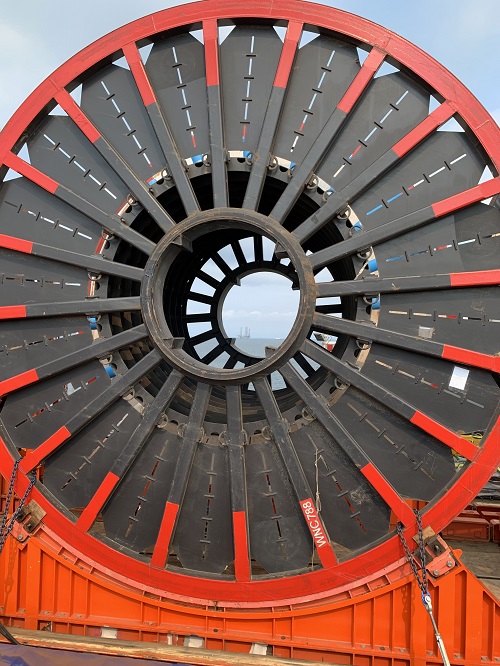
Waithman ran the Etame reconfiguration project, but also headed facilities engineering, which meant he also oversaw all the normal Etame engineering operations.
And because Etame was VAALCO’s single source of income, it was critical that the Petroleo Nautipa FPSO remain in production as long as possible before the switchover to the Teli FSO. During the roughly 18-month project, it was necessary to install 5,100 m of new subsea flexible pipe, make multiple subsea connections, tie-in pipelines and pressure test them, connect risers to the new FSO, disconnect production lines from the FPSO, alongside the annual maintenance turnaround.
The projects were in progress when COVID had become a daily fact of life for the oil and gas industry, resulting in widespread worker shortages due to layoffs or illness and a myriad of supply chain disruptions, Waithman said.
In the lead-up to COVID, he noted, companies stocked “minimum inventory” but started buying up additional inventory as COVID persisted. In short, he said, commodity items became very difficult to locate and acquire.
Sometimes moving those items around the globe was problematic. For instance, he said, mooring chain shipped out of Shanghai wasn’t able to leave the city, so a replacement mooring had to come from Norway.
“The logistics were really complex,” Maxwell said.
And, as Waithman put it, “The systems were pushed to the limit.”
In the end, people worked to find solutions because giving up wasn’t an option.
“If we didn’t get the separator, we couldn’t just produce into a large bucket,” Waithman said, noting each piece of equipment’s timely arrival was critical to meeting the schedule while oil was still producing to the FPSO prior to the switch out.
“We [had] to make this work. All the bits are connected. Something a month late has a knock-on effect,” he said.
Maxwell said all the project’s stress, interfaces, expediting efforts and calls were a prelude for the apex of the hook up.
“This project was a choreographed dance that had to happen. This vessel has to arrive, but without the chains, it just bobs around. Without connections, it can’t process oil,” Maxwell said.
The engineering and reconfiguration work wasn’t overly complicated, Waithman said. What complicated factors was the fact that VAALCO “ran the installation campaign around what was happening live with production operations.”
The Boor Norve drilling rig was on the field at the time, drilling two of the four wells.
“It was a beast, and it had its own needs,” Waithman said.
Typically, Etame required about 50 people offshore supporting operations. The peak of the reconfiguration activity required more than 600 workers.
“We had a flotilla out there, an armada of ships” including boats, accommodation barges, anchor handlers, saturation diving vessels, platform supply vessels and more, Waithman recalled.
The Petroleo Nautipa FPSO was offloaded for the final time from Etame in late September 2022, and first oil was delivered to the Teli FSO in mid-October. The FPSO is being decommissioned and will leave Gabon under the control of BW Offshore.
De-risked revenue stream
VAALCO has increased the size of the company and taken more equity in Etame in a deal that closed in March 2021 with a July 2020 effective date.
The company now operates the Etame Marin Permit with 63.6% working interest on behalf of partners Sinopec (Addax Petroleum) with 33.9% and PetroEnergy with 2.5% interest. In July 2022, it strategically combined with TransGlobe Energy Corp., which includes assets in prolific and established basins in Egypt and Canada.
For so long, the company had one single point of revenue, which has since “transformed to three points of revenue and de-risked the revenue stream for the company,” Maxwell said.
Five years ago, VAALCO was worth $40 million, gradually creeping up to $70 million over the next couple of years. Now, he said, the company is moving out of microcap status with a market value exceeding $500 million.
“We are moving toward small cap in a big way,” he said.
Recommended Reading
Ithaca Energy to Buy Eni's UK Assets in $938MM North Sea Deal
2024-04-23 - Eni, one of Italy's biggest energy companies, will transfer its U.K. business in exchange for 38.5% of Ithaca's share capital, while the existing Ithaca Energy shareholders will own the remaining 61.5% of the combined group.
EIG’s MidOcean Closes Purchase of 20% Stake in Peru LNG
2024-04-23 - MidOcean Energy’s deal for SK Earthon’s Peru LNG follows a March deal to purchase Tokyo Gas’ LNG interests in Australia.
TotalEnergies to Acquire Remaining 50% of SapuraOMV
2024-04-22 - TotalEnergies is acquiring the remaining 50% interest of upstream gas operator SapuraOMV, bringing the French company's tab to more than $1.4 billion.
TotalEnergies Cements Oman Partnership with Marsa LNG Project
2024-04-22 - Marsa LNG is expected to start production by first quarter 2028 with TotalEnergies holding 80% interest in the project and Oman National Oil Co. holding 20%.
Is Double Eagle IV the Most Coveted PE-backed Permian E&P Left?
2024-04-22 - Double Eagle IV is quietly adding leases and drilling new oil wells in core parts of the Midland Basin. After a historic run of corporate consolidation, is it the most attractive private equity-backed E&P still standing in the Permian Basin?


